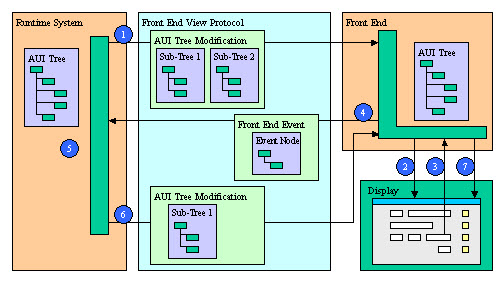The front end protocol (FEP) is an internal protocol used by the runtime system to synchronize the abstract user interface (AUI) representation on the front end side. This protocol defines a simple set of operations to modify the AUI tree. This protocol is based on a command processing principle (send command, receive answer) and can be serialized to be transported over any network protocol, like HTTP for example.

Figure 1. Typical communication between the Runtime System and the Front End
- Initialization phase: The runtime system sends the initial AUI tree.
- The front end builds the graphical user interface according to the AUI tree.
- The front end waits for a user interaction (mouse click, keyboard typing).
- When the user performs some interaction, the front end sends front end events corresponding to the modifications made by the user.
- Front end events are analyzed and validated by the runtime system.
- The runtime system sends back the result of the front end requests, by the way of AUI tree modifications commands.
- When receiving these commands, the front end modifies its version of the AUI tree and updates the graphical user interface. It then waits for new user interactions (step 3).